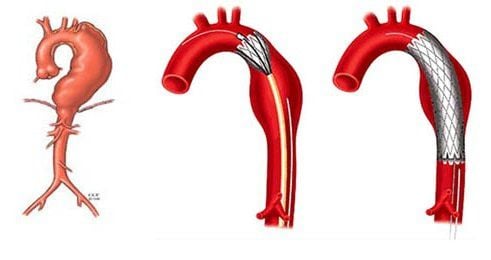This is an automatically translated article.
The article was professionally consulted by a doctor at the Cardiology Center - Vinmec Times City International General Hospital.Normally, the aortic valve consists of 3 slender leaflets that open and close rhythmically according to the action of the heart, allowing blood to flow in one direction from the left ventricle to the aorta. Aortic regurgitation is defined as a condition in which the valve does not close properly, allowing some of the blood that has been pumped into the aorta to flow back into the left ventricle.
1. What causes aortic regurgitation?
Aortic regurgitation can be caused by disease of the leaflets or the aortic root. In our country, the leading cause of aortic regurgitation is still rheumatic heart disease, which causes thickening and retraction of the valve leaflets.Other possible causes are: congenital mitral aortic valve prolapse, infective endocarditis causing perforation of the leaflet, aortic valve prolapse due to ventricular septal defect.
Diseases that cause aortic root dilation that can cause aortic regurgitation are persistent hypertension, pathologies that cause aortic aneurysms, hereditary diseases such as Marfan syndrome, Fallot disease at stage 4. late.
2. What are the consequences of aortic valve regurgitation?
Aortic regurgitation will result in both volume and pressure overload which is different from mitral regurgitation that is only volume overloaded. The left ventricle can endure this overload for a long time, possibly with the risk of mitral regurgitation. over decades. The response of the left ventricle is dilation and hypertrophy, the shape changes to a more circular direction. Usually the left ventricular ejection fraction will be preserved until the late stages of the disease.3. How does the disease manifest?
Depending on the cause of the aortic regurgitation, symptoms can be gradual or intense (as in infective endocarditis). Most cases of chronic valvular regurgitation have few symptoms, unless in the late stages of the disease. Symptoms may include dyspnea on exertion or unexplained fatigue. There are some patients who are so tired that they run out of breath after a day's work. In contrast to aortic stenosis, patients rarely experience chest pain or syncope. Patients or family members may detect signs of palpitations, heart palpitations. Obvious symptoms of heart failure, such as shortness of breath, or chest pain when they appear, indicate that the disease is already at an advanced stage.
Hầu hết các trường hợp hở van động mạch chủ đều có ít triệu chứng.
4. How is the disease detected?
Clinical examination can lead to the diagnosis of the disease with the following symptoms: Strong pulse, high systolic blood pressure and low diastolic auscultation with characteristic diastolic murmur.Electrocardiogram: Expression of left ventricular volume overload, extrasystoles are common. Echocardiography Evaluates left ventricular size and function (important ejection fraction). Detect accompanying aortic pathologies, especially cases of aortic regurgitation secondary to aortic root dilatation Morphology of the aortic valve, thereby evaluating the cause of aortic regurgitation such as aortic valve with only two leaflets, thickened valve of rheumatic heart, mitral prolapse... Degree of aortic regurgitation Due to the advancement of echocardiography, cardiac catheterization and angiography are no longer indicated. to diagnose aortic regurgitation. However, catheter angiography may be advisable in patients with high risk factors for coronary artery disease.
5. How is drug treatment?
Drug therapy cannot cure aortic regurgitation, but it still has an active role in patients who are asymptomatic or for whom surgery is not indicated. Vasodilators: ACE inhibitors may not be effective in the early stages of the disease when the Renin-Angiotensin system is not activated. In the later stages, this is again the basic treatment. Dihydropyridine calcium channel blockers (such as Amlodipine) are most important in the early stages. Beta-blockers prolong diastole, theoretically not beneficial, but should still be used in small doses because of the increased risk of heart failure. Relationship between aortic regurgitation and aortic aneurysm. When using, it is necessary to closely monitor the heart rate to prevent bradycardia. Patients should consult a cardiologist carefully about physical activities. Patients should avoid heavy hand activities such as weight training, weightlifting because it will increase peripheral impedance by reflex mechanism increasing the burden on the heart. However, cycling should be encouraged because regular exercise of large muscle groups in the lower extremities should have a vasodilating effect and create a feeling of wellness.
6. Disease progression and monitoring
Patients with severe aortic regurgitation may suffer for years before symptoms appear. Unlike aortic stenosis, the risk of sudden death in patients with aortic regurgitation is not high (<0.2% per year). However, when left ventricular function decreases, symptoms will appear, once symptoms are present, the risk of death will be 10%. For patients with mild and moderate aortic regurgitation, it is recommended to have regular annual examinations and have You may only need an echocardiogram every two years. For patients with severe aortic regurgitation, an echocardiogram and examination should be performed every 6 months.7. When should surgery?
When the patient presents with dyspnea or chest pain When the patient is asymptomatic but the left ventricular function is reduced (EF<50%), or although the left ventricular systolic function is preserved, the left ventricle is dilated (DD>75mm or DS>55mm) Valve replacement may also be indicated after discussing the benefits of surgery in patients at the border of surgery: * Patients without symptoms, functional Left ventricular systolic function preserved, left ventricle dilated to a degree (DD>70mm or DS>50mm). Patients with moderate aortic regurgitation require other cardiac surgery (eg, coronary artery bypass grafting).
8. Surgical treatment of aortic valve regurgitation like?
Aortic valve replacement: This is the most commonly performed of the methods. There are two types of valves commonly used: mechanical valves and biological valves. Depending on age, medical condition, gender as well as other points, the doctor and patient will discuss choosing the most suitable valve Aortic valve repair surgery: In some cases, the surgeon can repair aortic valve replacement (aortic prolapse, mitral aortic valve, aortic regurgitation due to dilation of the aortic root) When there is accompanying dilatation of the aortic root, the surgeon can replace the aortic root aortic valve and both aortic valve (Bentall surgery) or replace the aortic root and keep the aortic valve (David operation) The aortic valve can also be replaced by the patient's own valve (using the aortic valve). Autologous pulmonary valve replacement - Ross surgery). However, this surgery only makes sense for a small group of patients (such as children) because in the long run, it will put the patient in a state of two-valve disease while initially only hurting one valve. : This is a method of using heart valves from donated brain dead patients. This method is very effective in cases of infective endocarditis because the ability of the allogeneic valve to fight pathogens is better than that of artificial heart valves. However, in the long term, allogeneic heart valves are not better than artificial heart valves, and the surgery is more complicated than artificial heart valves. Currently, Cardiovascular Center - Vinmec International General Hospital is one of the leading centers in the country for examination, diagnosis, screening and treatment of cardiovascular diseases. Vinmec not only has the convergence of a team of experienced and reputable leading experts in the field of surgical, internal medicine, interventional cardiac catheterization, but also has a system of modern equipment, on par with The most prestigious hospitals in the world such as: MRI 3 Tesla (Siemens), CT 640 (Toshiba), EVIS EXERA III high end endoscopes (Japan Olympiad), high anesthesia system Avace level, Hybrid operating room according to international standards... Especially, with the space designed according to 5-star hotel standards, Vinmec ensures to bring the patient comfort, friendliness and peace of mind. .
Please dial HOTLINE for more information or register for an appointment HERE. Download MyVinmec app to make appointments faster and to manage your bookings easily.













